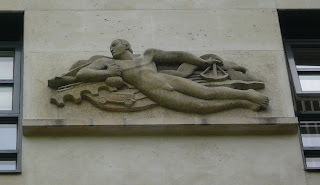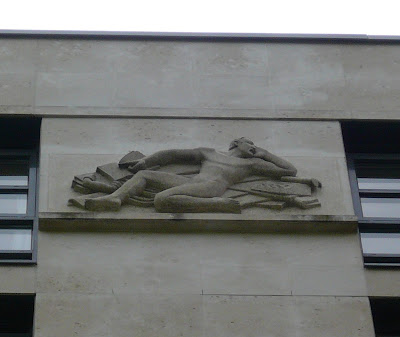 Neville House is a brand-spanking new block of flats in that oddly quiet hinterland behind Millbank. A sequence of clearly much-older relief panels runs up the main facade, and I could find no reference to them anywhere, not in Pevsner or the Encyclopedia of London, and Google for once failed. Finally the mystery was solved by a request to the developers, Berkeley Homes. They sent an extract from a press release issued when the place was built a few years ago:
Neville House is a brand-spanking new block of flats in that oddly quiet hinterland behind Millbank. A sequence of clearly much-older relief panels runs up the main facade, and I could find no reference to them anywhere, not in Pevsner or the Encyclopedia of London, and Google for once failed. Finally the mystery was solved by a request to the developers, Berkeley Homes. They sent an extract from a press release issued when the place was built a few years ago:The original Neville House was built in 1952, so Bainbridge Copnall's sculptures must represent the thrusting 'white heat of technology' aspirations of the time.'Neville House was a seven-storey government occupied office block, designed by architectural practice TP Bennett & Son. The building included a number of tablets on its original façade depicting the revolution of the modern era and future technology designed by renowned sculptor Edward Bainbridge Copnall. These tablets are being retained by Berkeley Homes to be displayed on the façade of the new Neville House building and will act as a link to its history as well as being forms of art in their own right.'
 The one over the front door (picture at top) represents Engineering wrestling with a lever and ratchet of some sort, with a rather strange assortment of cogs, wheels and riveted steel behind. Above him (picture at right) is Transport whizzing through the air with a bag of gold and a sextant. A railway bridge with a steam train crosses over a road with a car that must have looked antique even in 1952. An airliner swoops overhead and an ocean liner ploughs the sea behind. Very busy.
The one over the front door (picture at top) represents Engineering wrestling with a lever and ratchet of some sort, with a rather strange assortment of cogs, wheels and riveted steel behind. Above him (picture at right) is Transport whizzing through the air with a bag of gold and a sextant. A railway bridge with a steam train crosses over a road with a car that must have looked antique even in 1952. An airliner swoops overhead and an ocean liner ploughs the sea behind. Very busy. Tilt your head further back and there's Trade, running with parcels, boxes, bales and chests of merchandise. 'Export or Die' was the government cry at the time.
Tilt your head further back and there's Trade, running with parcels, boxes, bales and chests of merchandise. 'Export or Die' was the government cry at the time.And right at the top is Bureaucracy, on one knee before a desk with a typewriter surrounded by piles of memos, ledgers and files. A telephone handset lies on top, and he is turning to yell "It's for you!" at one of his colleagues.
These beautiful pieces are filled with tremendous movement and vitality but represent a world that has utterly vanished. Copnall may have intended to represent the future of technology, but it was already in the past.








